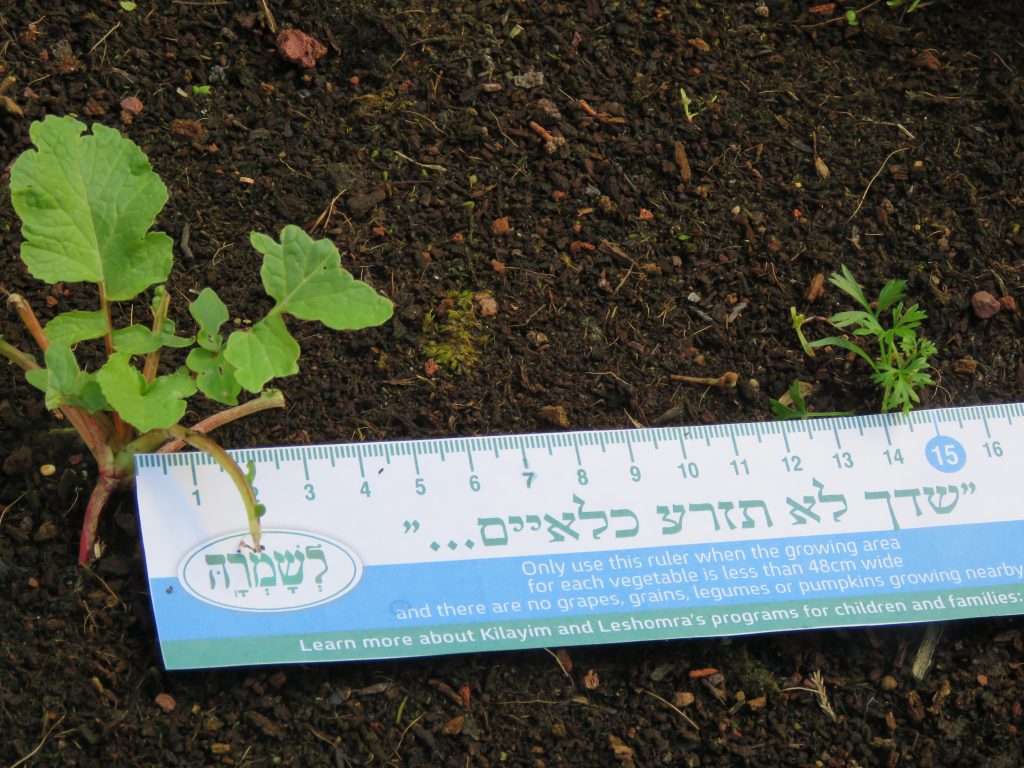Free Gift: Leshomra’s Unique Printable Kilayim Ruler and Guide
In the last months, Leshomra kids have planted over 10,000 seedlings in 121 mini-farms in Charedi schools, kindergartens and community facilities across Israel.
For many this is their first time planting anything in their lives, so we teach about a Torah mitzvah called “Kilayim” – the prohibition of planting different food species together.

The Kilayim ruler is used here to measure the distance between radish and carrot seedlings.
We’ve noticed that unfamiliarity with these mitzvahs makes many religious Jews nervous to grow edible plants. What a shame! They are not only missing out of the joy of homegrown vegetables, they are missing out on an opportunity to perform a mitzvah that is so neglected these days.
At Leshomra, we’re on a mission to make the laws of Kilayim simple to understand and follow.
We’ve created a first-ever “Kilayim ruler” that makes it very clear and doable for anyone. You can download your own Kilayim Ruler below.
Quick Halachic Overview of Kilayim
If you’re planting two different vegetable species, for example, carrots and radishes, you must leave 15cm between the plants. (Note: 15cm is the measurement according to the Chozon Ish. There are other rabbinic opinions that say a shorter distance is acceptable.)
The 15cm point is marked on the ruler to make this easy. Measure from the point that the stalks enter the ground. As long as the point where stalks going into the ground are far enough apart, it doesn’t matter if the leaves are closer – even if they touch.
If you’re planting legumes or grains, you should leave a gap of 60cm between species (e.g. between wheat and peas, or sunflowers and beans).
Here’s an interesting point most people aren’t aware of: keep each species in a growing area no more than 48cm wide. It can be as long as you like but if it’s more than 48 cm wide, the measurements for Kilayim purposes change.
The Deeper Significance of Kilayim
We all think about the meaning of mitzvas like Shabbos and Honoring Our Parents, but it seems no one thinks about the deep, sacred significance of Kilayim – probably because most observant Jews live long lives without ever actively performing this mitzvah even once!
Though this is a mitzvah which it is hard to understand logically, the Ramban wrote that each plant species was created in the Upper Worlds and Hashem blessed it with continued existence. Therefore tampering with species by deliberately crossing two completely different species can be considered tampering with the divinely ordained order of the Universe.
Therefore, says the Ramban, we keep the species separate so they won’t cross-breed. (Vayikra 19:19)
Go Do it Now
Today is the perfect day for you to perform the mitzvah of avoiding Kilayim for the first time in your life! Do it with your kids, your students, your friends, your inner child.
If you don’t have seeds on hand, crack open a tomato or pepper or winter squash. Sprouted potatoes, garlic or carrot tops also work.
Happy planting!
Downloads
Download Leshomra’s Kilayim ruler with English Instructions
Download Leshomra’s Kilayim ruler with Hebrew Instructions (tested in 121 mini-farm around Israel!)
(Note: when printing the ruler, make sure your printer isn’t resizing it to fit the page. This will distort the measurements.)
